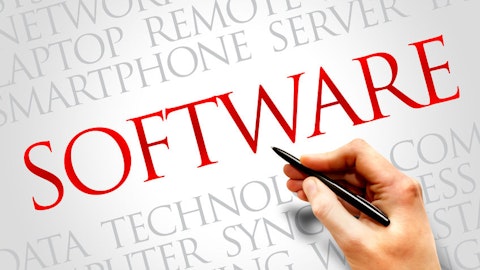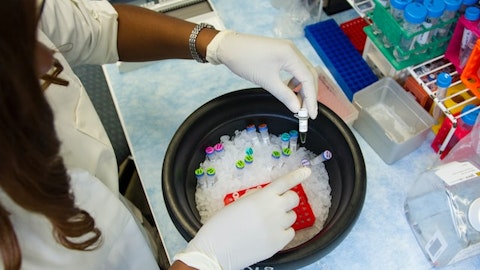Matt Hewitt: Got it. That’s super helpful. And then maybe looking at the backlog, obviously, there was a nice pop there. Some of that was a contribution from anynetrics versus — it sounds like the rest of that was just a solid effort from your sales and marketing team. Is there any way to break out the contribution from ImmuMetrix into your backlog?
Will Frederick: Yes. We’ve now broken out ImmuMetrix Society. We’ve not broken out the backlog historically by business unit in terms of the disciplines of PKPD and QSP and PBPK — it was — I can say this, it was yes, I mean that contributed batt there, we’re dealing with a handful of accounts and a handful of projects. So while it’s in addition, it’s not the most significant, I’d say the most significant contributor there was a record quarter in terms of the bookings on the PKPD side, I think it was the largest in our history, although we did go back all the way to early records there. Very good quarter in terms of that discipline. — number of projects that are teed up beginning in the first quarter here, but certainly in the early part, early half of fiscal ’24. So the largest contributor to that backlog increase was out of the PKPD business.
Matt Hewitt: Got it. And then maybe last one, and then I’ll hop back in the queue. Regarding the cross-selling opportunities, it sounds like there’s been a very positive reception. And it goes both ways. It sounds like both of your installed base as well as with the ImmuMetrix customers. But are you having some early success on the actual cross sales? Or is this more about building those relationships and kind of introducing them to the full product offering?
Will Frederick: Yes. I’d say, Matt, the biggest activity is within the QSP space. in terms of the discipline or therapeutic areas, I should say, on the ImmuMetrix side, providing visibility to our customers that don’t overlap with theirs, the capabilities that we now have in adding names and opportunities to the pipeline to sell ImmuMetrix models into that client base. In the other direction, ImmuMetrix comes to us with a small number of clients, less one digit in terms of total clients. And many of those are large pharma that are customers of our other platform software products, et cetera. So cross-selling into their installed base is a benefit that’s not a big contributor. The biggest contributor is in the direction of bringing memetic models into our much larger client base and creating opportunities to sell those models through to that community.
Operator: Thank you. Our next question is from David Larsen with BTIG. Please proceed with your question.
David Larsen: Hi. Can you talk a little bit about like GastroPlus? I think you had 10 new customers, which looked very good. I think that compares to like four in the previous quarter, and it was the highest quarter, I think, of the year, maybe in the past two years and then 11 up-sells, which also looked good. But I think your revenue actually for GastroPlus maybe declined sequentially despite the large number of new customers and up-sells, can you just talk a little bit about what drove that? And is it the renewal rates based on both fees and accounts?
Will Frederick: Yes. It’s a couple of things there, Dave. One, yes, sequential quarters, keep in mind that the revenue for a software revenue for a given product or total software revenues from quarter-to-quarter because of — it’s not a — it’s a recognition entirely upfront, 12-month license revenue taken on day one. So it doesn’t build upon itself. And from third quarter to fourth quarter, you’re really dealing with what’s the population renewals in back quarter driving that number. And so I think while the harmonization process left us in absolute dollar revenue level equivalent in the second, third and fourth quarter, I think there’s a little hiking to be a little higher than fourth quarter, and that contributed there as well.
as well in the fourth quarter, we saw a couple of non-renewals that impacted the renewal rate numbers that you saw were lost opportunities through M&A activity. And so that brought the fourth quarter down from where it could have been and those two acquisitions not contributed to the mix. few biotech gene on renewals and a couple of CRO non-renewals. There were a couple of QSP licenses relatively small dollar amounts, but the programs for which they will be used to just continue. So we had a few non-renewals in the fourth quarter that contributed to those renewal rates coming down. Our typical experience here, often those M&A events lead to ultimately when the two companies sort and sell out fully. Those discussions reinvigorate and could come back to us.
So they are now in our pipeline, if you will, and some of that can come back to us down the line. But oftentimes, the immediate reaction once the combined organizations come together in an environment right now, what’s not renewed and then we’ll look at it down the road when the test level. So a few impacts from non-renewals in the fourth quarter or those numbers could have been higher.
David Larsen: That’s very helpful. If you had to guess how much of the M&A impacted revenue in the quarter, — is there any sort of gas or ballpark figure? Could it have been $0.5 million, $1 million? Just any sense for that?
Will Frederick: I don’t know that that’s a level of sort of estimations I want to get into. You could go back and you could say, “Geez, our historical renewal of fee rates is X and it was Y in the fourth quarter probably come to an estimate there of a magnitude impactful would look forward to 24 playing out, and we might see some of that revenue come back to us.
David Larsen: Okay. And then in terms of price increases, any — just any color on what you would expect to see in fiscal ’24 and what you were able to realize in fiscal ’23?; and then a long sort of related to that would be sort of wage inflation for your own science hits. Like do you have to increase prices in order to cover more wage inflation? Or is it a more tempered environment heading into next year? Any thoughts there would be very helpful.
Will Frederick: No, no, good question. Top line first, in terms of price increases. As we’ve stated before, we were more aggressive during fiscal year ’23 than we had been in the past and certainly was an environment with macroeconomic inflation down to specific market compensation increases in the industry for the scientific community in questions here, made that increased price increase, at least understandable as to its starting point, not that it didn’t come with negotiation and pushback, but we yielded very well in that environment. And I think it speaks to the capabilities of our team that we put together in terms of our client base organization as well as the partnership we have with our clients. They’re accepting of, hey, this is — those increases come back and or return back to them in terms of continuing to fund a very robust delivery out of our R&D organization with higher quality or functionality down growth.
So our yield was doubled in ’24 versus ’23. That price increase was quite as much as it typically has been in the past. As we turn to ’24, a little bit different market. inflation’s still present out there still though with an environment in which our clients are pretty budget constrained. And the biggest difference is that on the other side, the expense side, there’s been a settling down of the marketplace in terms of the cost science is some field and the job of a that somewhat contributes to inflated compensation offers out there has settled down. And so certainly, that momentum goes away and our expectations in ’24 returned back somewhere between 22% and 23% in terms of anticipated price increases as we go forward into next year; so good yield in ’23 in terms of price increase more significant than in the past.





